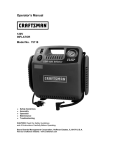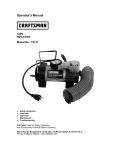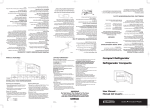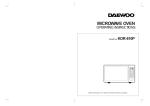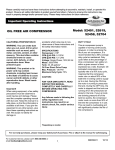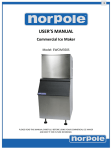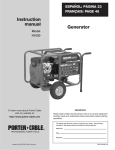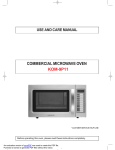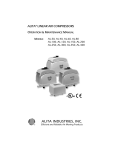Download Makita AC001 Troubleshooting guide
Transcript
OWNERS MANUAL FOR Oil Free Air Compressor MODEL No $C SPECIFICATION CHART Model # AC001 Horsepower 1/6 HP SCFM @ 40 PSIG 0.58 SCFM @ 90 PSIG 0.45 Cut-In Pressure 95 PSI Cut-Out Pressure 125 PSI Bore 32 mm Stroke 11 mm Voltage -Single Phase Motor RPM Amperage @ max pressure 120 3400 1.8 Tank Size 1 Gallon CSA/US Listed Yes Minimum Circuit Requirement: 15 AMPS *A circuit breaker is preferred. Use only a fuse or circuit breaker that is the same rating as the branch circuit the air compressor is operated on. If the air compressor is connected to a circuit protected by fuses, use time delay fuses. IMPORTANT — Read the Safety Guidelines and ALL instructions carefully before operating. www.makita.com TABLE OF CONTENTS SAFETY INSTRUCTIONS . . . . . . . . . . . . . . . . . . . . . . . . . . . . . . . . 3 Warning Chart . . . . . . . . . . . . . . . . . . . . . . . . . . . . . . . . . . . . . . . 3 GLOSSARY . . . . . . . . . . . . . . . . . . . . . . . . . . . . . . . . . . . . . . . . . . . . 7 DUTY CYCLE . . . . . . . . . . . . . . . . . . . . . . . . . . . . . . . . . . . . . . . . . . 7 GENERAL INFORMATION . . . . . . . . . . . . . . . . . . . . . . . . . . . . . . . . . 7 ON-RECEIPT INSPECTION . . . . . . . . . . . . . . . . . . . . . . . . . . . . . . . 7 STORAGE . . . . . . . . . . . . . . . . . . . . . . . . . . . . . . . . . . . . . . . . . . . . . 8 DESCRIPTION OF OPERATION . . . . . . . . . . . . . . . . . . . . . . . . . . . 8 INSTALLATION and BREAK-IN PROCEDURES . . . . . . . . . . . . . . . 9 Location Of the Air Compressor . . . . . . . . . . . . . . . . . . . . . . . . . .9 Initial Start Up Procedure: . . . . . . . . . . . . . . . . . . . . . . . . . . . . . .10 Extension Cords . . . . . . . . . . . . . . . . . . . . . . . . . . . . . . . . . . . . .10 Piping . . . . . . . . . . . . . . . . . . . . . . . . . . . . . . . . . . . . . . . . . . . . .10 Grounding Instruction . . . . . . . . . . . . . . . . . . . . . . . . . . . . . . . . .10 OPERATING PROCEDURES . . . . . . . . . . . . . . . . . . . . . . . . . . . . . 11 Daily Start-up Checklist . . . . . . . . . . . . . . . . . . . . . . . . . . . . . . . .11 MAINTENANCE . . . . . . . . . . . . . . . . . . . . . . . . . . . . . . . . . . . . . . . 12 ROUTINE MAINTENANCE SCHEDULE . . . . . . . . . . . . . . . . . . . . 12 SERVICE INSTRUCTIONS . . . . . . . . . . . . . . . . . . . . . . . . . . . . . . . 13 TROUBLESHOOTING GUIDE . . . . . . . . . . . . . . . . . . . . . . . . . . . . 14 MAINTENANCE LOG . . . . . . . . . . . . . . . . . . . . . . . . . . . . . . . . . . . 17 SERVICE CENTERS . . . . . . . . . . . . . . . . . . . . . . . . . . . . . . . . . . . . 18 WARRANTY . . . . . . . . . . . . . . . . . . . . . . . . . . . . . . . . . . . . . . . . . . .19 Page 2 IMPORTANT SAFETY INSTRUCTIONS *SAVE THESE INSTRUCTIONS* WARNING IMPROPER OPERATION OR MAINTENANCE OF THIS PRODUCT COULD RESULT IN SERIOUS INJURY AND PROPERTY DAMAGE. READ AND UNDERSTAND ALL WARNINGS AND OPERATING INSTRUCTIONS BEFORE USING THIS EQUIPMENT. HAZARD Risk of Unsafe Operation WHAT CAN HAPPEN HOW TO PREVENT IT Unsafe operation of your air compressor could lead to serious injury to you or others. • Review and understand all instructions and warnings in this manual. • Become familiar with the operation and controls of the air compressor. • Keep operating area clear of all persons, pets, and obstacles. • Keep children away from the air compressor at all times. • Do not operate the product when fatigued or under the influence of alcohol or drugs. Stay alert at all times. • Never defeat the safety features of this product. • Equip area of operation with a fire extinguisher. • Do not operate machine with missing, broken, or unauthorized parts. Page 3 HAZARD Risk of Air Tank Bursting Risk of Attachments and Accessories Bursting Page 4 WHAT CAN HAPPEN HOW TO PREVENT IT The following conditions could lead to a weakening of the tank, and RESULT IN A VIOLENT TANK EXPLOSION RESULTING IN SERIOUS INJURY TO YOU OR OTHERS: • Failure to properly drain condensed water from the tank, causing rust and thinning of the tank wall. • Modifications or attempted repairs to the tank. • Unauthorized modifications to the pressure switch, safety valve, or any other components, which control tank pressure. · Drain the tank DAILY or after each use. If tank develops a leak, replace it immediately with a new tank or new compressor unit. · Never drill into, weld, or make any modifications to the tank or its attachments. Never attempt to repair a damaged or leaking tank. Replace with a new tank. · The tank is designed to withstand specific operating pressures. Never make adjustments or parts substitutions to alter the factory set operating pressures. · For essential control of air pressure, you must install a pressure regulator and regulated air pressure guage to the air outlet of your compressor. Exceeding the pressure · Follow the equipment rating of air tools, spray manufacturers guns, air operated recommendation and never accessories, tires AND exceed the maximum other inflatables can allowable pressure rating of cause them to explode attachments. Never use the or fly apart, and could compressor to inflate small result in serious injury low-pressure objects such to you and others. as children's toys, footballs, basketballs, etc. HAZARD Risk of Electric Shock Risk of Explosion or Fire Risk to Breathing WHAT CAN HAPPEN HOW TO PREVENT IT • Your air compressor is powered by electricity. Like any other electrically powered device, if it is not used properly, it may cause electrical shock. • Electrical grounding: failure to provide adequate grounding to this product could increase the risk of electric shock. • Any electrical wiring or repairs required to this product should be performed by qualified service personnel or a licensed electrician, in accordance with national and local electrical codes. • Make certain that the electrical circuit to which the compressor is connected provides proper electrical grounding, correct voltage, and adequate fuse protection. • Never operate the compressor outdoors when it is raining, or in a wet environment. It is normal for electrical contact within the motor and pressure switch to spark, whenever the compressor starts or stops. Never operate the compressor in an atmosphere where flammable vapors are present. Doing so can result in serious injury to you or others. • Always operate the compressor in a wellventilated area, free of gasoline or solvent vapors. • If spraying flammable materials, locate compressor at least 20 feet away from spray area. • Store flammable materials in a secure location away from compressor. • The compressed air • Never inhale air from the from your compressor, either directly compressor is not or from a breathing device safe for breathing. connected to the The air stream may compressor. Work in an contain carbon area equipped with good monoxide or other cross ventilation. vapors, or particles • Read and follow the from the tank or other safety instructions components. provided on the label or • Sprayed materials safety data sheet for the such as paint, paint material you are spraying. Page 5 HAZARD Risk to Breathing (continued) Risk from Compressed Air Risk from Moving Parts Risk of Burn Page 6 WHAT CAN HAPPEN solvents, paint remover, insecticides, weed killers, etc., contain harmful vapors and poisons. • Breathing compressor or sprayed materials vapor can result in serious injury. HOW TO PREVENT IT Use an approved respirator designed for use with your specific application. The compressed air • Always wear approved stream can cause soft safety glasses with side tissue damage, and can shields when using the propel dirt, chips, loose compressor. particles and small objects • Never point any nozzle at high speed, resulting in or sprayer toward any property damage or part of the body or at personal injury. other people or animals. • Always turn the compressor off and bleed pressure from the air line before attempting maintenance, attaching tools or accessories. The compressor cycles • Always unplug the automatically when the compressor and pressure switch is in the release air pressure on/auto position. If you from the tank and any attempt repair or attachments before maintenance while the attempting any compressor is operating or maintenance or repair. plugged in, you can • Never operate the expose yourself to moving compressor with guards parts. These moving parts or covers which are can cause serious injury. damaged or removed. Contact with hot parts such as the compressor head or outlet tubes could result in a serious skin burn. • Never touch hot components during or immediately after operation of the compressor. Do not reach around protective shrouds or attempt maintenance until unit has been allowed to cool. GLOSSARY CFM: Cubic feet per minute. SCFM: Standard cubic feet per minute; a unit of measure of air delivery. PSIG: Pounds per square inch gauge; a unit of measure of pressure. CUT-IN PRESSURE: While the motor is off, air tank pressure drops as you continue to use your accessory or air tool. When the tank pressure drops to a certain level the motor will restart automatically re-started is called "cut-in pressure". CUT-OUT PRESSURE: When you turn on your air compressor, it begins to run, air pressure in the air tank begins to build. It builds to a certain pressure before the motor automatically shuts off - protecting your air tank from pressure higher than its design rating. The pressure at which the motor shuts off is called "cut-out pressure". DUTY CYCLE All Makita manufactured air compressors are recommended to be operated on not more than a 50% duty cycle. This means an air compressor that pumps air more than 50% of one hour is considered misuse because the air compressor is undersized for the required air demand. GENERAL INFORMATION This air compressor does not use oil. Now you can enjoy all the benefits of having an oil free air compressor. compressor. When oil is changed regularly, it will give you long, trouble-free life. Your air compressor can be used for operating paint spray guns, air tools, caulking guns, grease guns, air brushes, sandblaster, inflating tires or spraying weed killers, insecticides, etc. An air pressure regulator is supplied for these applications. Separate air transformers which combine the functions of air regulation and/or moisture and dirt removal should be used where applicable. ON-RECEIPT INSPECTION DAMAGE: Each air compressor outfit is carefully tested and checked before shipment. With improper handling, damage may result in transit and cause problems with compressor operation. Immediately upon arrival, check equipment for both concealed and visible damages to avoid expenses being incurred to correct such problems. This should be done regardless of any visible signs of damage to the shipping container. If this Page 7 product was shipped directly to you, report any damages to the carrier and arrange for inspection of goods immediately. STORAGE Before you store the air compressor, make sure you do the following: 1. Review the “Maintenance” and “Operating Procedures” sections and perform maintenance as necessary. Be sure to drain water from the air tank. 2. Protect the electrical cord and air hose from damage (such as being stepped on or run over). Store the air compressor in a clean and dry location. DESCRIPTION OF OPERATION DRAIN VALVE: The drain valve is located at the bottom of the air tank and is used to drain condensation at the end of each use. MOTOR THERMAL OVERLOAD PROTECTOR: The electric motor has an automatic thermal overload protector. If the motor overheats for any reason, the thermal overload protector will shut off the motor. Turn pressure switch to the “off” position and wait for unit to cool before pushing the reset button and restarting the compressor. ON/AUTO - OFF SWITCH: Turn this switch to “on” to provide automatic power to the pressure Page 8 switch and to “off” to remove power when finished using the compressor or when compressor will be left unattended. AIR INTAKE FILTER: This filter is designed to clean air coming into the compressor pump. This filter must always be clean and free from obstructions. See “Maintenance”. AIR COMPRESSOR PUMP: To compress air, the piston moves up and down in the cylinder. On the down stroke, air is drawn in through the air intake valve. The exhaust valve remains closed. On the upstroke of the piston, air is compressed. The intake valve closes and compressed air is forced out through the exhaust valve, through the outlet tube, through the check valve and into the air tank. Useable air is not available until the compressor has raised the air tank pressure above that required at the air outlet. CHECK VALVE: When the air compressor is operating, the check valve is “open”, allowing compressed air to enter the air tank. When the air compressor reaches “cut-out” pressure, the check valve “closes”, allowing air pressure to remain inside the air tank. PRESSURE SWITCH UNLOADING VALVE: The pressure switch unloading valve located on the side of the pressure switch, is designed to automatically release compressed air from the compressor head and the outlet tube when the air compressor reaches “cut-out” pressure. PRESSURE SWITCH: The pressure switch automatically starts the motor when the air tank pressure drops to the factory set “cut-in” pressure. It stops the motor when the air tank pressure reaches the factory set “cut-out” pressure. SAFETY VALVE: If the pressure switch does not shut off the air compressor at its “cut-out” pressure setting, the safety valve will protect against high pressure by “popping out” at its factory set pressure (slightly higher than the pressure switch “cut-out” setting). OUTLET PRESSURE GAUGE: The outlet pressure gauge indicates the air pressure available at the outlet side of the regulator. This pressure is controlled by the regulator and is always less or equal to the tank pressure. See “Operating Procedures”. TANK PRESSURE GAUGE: The tank pressure gauge indicates the air pressure in the tank. REGULATOR: The air pressure coming from the air tank is controlled by the regulator knob. Turn the knob clockwise to increase pressure and counterclockwise to decrease pressure. To avoid minor re-adjustment after making a change in pressure setting, always approach the desired pressure from a lower pressure. When reducing from a higher to a lower setting, first reduce to some pressure less than desired pressure. Depending on the air requirements of each particular accessory, the outlet regulated air pressure may have to be adjusted while you are operating the accessory. INSTALLATION AND BREAK-IN PROCEDURES LOCATION OF THE AIR COMPRESSOR Locate the air compressor in a clean, dry and well-ventilated area. The air intake must be kept clear of obstructions, which could reduce air delivery of the air compressor. The air compressor should be located at least 12 inches away from the wall or other obstructions that will interfere with the flow of air. The air compressor head and shroud are designed to allow for proper cooling. If humidity is high, an air filter can be installed on the air outlet adapter to remove excessive moisture. LUBRICATION AND OIL CAUTION: Do not attempt to operate this air compressor without first adding oil to the crankcase. Serious damage will result from even limited operation unless filled with oil and broken in correctly. Make sure to closely follow initial start-up procedures. Compressor oil is provided; on a level surface, please fill the crankcase to proper level indicated on the sight glass. WARNING: Compressors are shipped without oil. A small Page 9 Initial Start Up Procedure: 1.Open the air receiver's drain valve. 2.Plug power supply cord into correct power source. 3.Run the compressor for a minimum of twenty (20) minutes in the no-load condition to seat the piston ring and check valves. 4.Close air receiver drain valve. Your compressor is now ready for use. Extension Cords To avoid voltage drop, power loss, and overheating of the motor, use extra air hose instead of an extension cord. Low voltage can cause damage to the motor. If an extension cord must be used: · Use only an approved 3-wire extension cord that has a 3blade grounding plug and a 3slot receptacle that will accept the plug on the air compressor. · Make sure the extension cord is in good condition. Please see the chart below as the MINIMUM requirements: Amp Rating (120 Volts) 10-12 12-14 14-16 16-18 18-20 Length of Cord in Feet 25' 16 16 16 14 14 50' 14 12 12 12 12 100' 10 10 10 8 8 150' 8 8 8 8 6 Piping Plastic or PVC pipe is not designed for use with compressed air. Regardless of its indicated pressure rating, plastic pipe can burst from air pressure. Use only metal pipe for air distribution lines. If a pipe line is necessary, use pipe that is the same size, or larger than, the air tank outlet. Piping that is too small will restrict the flow of air. If piping is over 100 feet long, use the next larger size. Bury underground lines below the frost line and avoid pockets where condensation can gather and freeze. Apply pressure before underground lines are covered to make sure all pipe joints are free of leaks. Grounding Instruction WARNING: Risk of electric shock! In the event if a short circuit, grounding reduces the risk of shock by providing an escape wire for the electric current. This air compressor must be properly grounded. The air compressor is equipped with a cord having a grounding wire with an appropriate Page 10 grounding plug. The plug must be used with an outlet that has been installed and grounded in accordance with all local codes and ordinances. The outlet must have the same configuration as the plug. DO NOT USE AN ADAPTER. Inspect the plug and cord before each use. Do not use if there are signs of damage. DANGER: Improper grounding can result in electrical shock. Do not modify the plug that has been provided. If it does not fit the available outlet, the correct outlet should be installed by a qualified electrician. OPERATING PROCEDURES Daily Start-up Checklist 1. Before attaching air hose or accessories, make sure the pressure switch lever is set to “OFF” and the air regulator or shut-off valve is closed. 2. Attach hose and accessories. Too much air pressure causes a hazardous risk of bursting. Check the manufacturer's maximum pressure rating for air tools and accessories. The regulator outlet pressure must never exceed the maximum pressure rating. 3. Turn the pressure switch lever to “ON/AUTO” and allow tank pressure to build. Motor will stop when tank pressure reaches “cut-out” pressure. 4. Open the regulator by turning it clockwise. Adjust the regulator to the correct pressure setting. Your compressor is ready for use. 5. Always operate the air compressor in well-ventilated areas; free of gasoline or other solvent vapors. Do not operate the compressor near the spray area. When you are finished: 6. Set the pressure switch lever to “OFF”. 7. Using the air tool or accessory, bleed the tank pressure down to zero. 8. Remove the air tool or accessory. 9. Drain water from air tank by opening drain cock valve on bottom of tank. WATER WILL CONDENSE IN THE AIR TANK. IF NOT DRAINED, WATER WILL CORRODE AND WEAKEN THE AIR TANK CAUSING A RISK OF AIR TANK RUPTURE. Note: If drain cock valve is plugged, release all air pressure. The valve can then be removed, cleaned, then reinstalled. 10. After the water has been drained, close the drain valve. The air compressor can now be stored. Page 11 MAINTENANCE WARNING: UNIT CYCLES AUTOMATICALLY WHEN POWER IS ON. WHEN DOING MAINTENANCE, YOU MAY BE EXPOSED TO VOLTAGE SOURCES, COMPRESSED AIR OR MOVING PARTS. PERSONAL INJURIES CAN OCCUR. BEFORE PERFORMING ANY MAINTENANCE OR REPAIR, UNPLUG THE COMPRESSOR AND BLEED OFF ALL AIR PRESSURE. To ensure efficient operation and longer life of the air compressor unit, a routine maintenance schedule should be prepared and followed. The following routine maintenance schedule is geared to a unit in a normal working environment operating on a daily basis. If necessary, the schedule should be modified to suit the conditions under which your compressor is used. The modifications will depend upon the hours of operation and the working environment. Compressor units in an extremely dirty and/or hostile environment will require a greater frequency of all maintenance checks. Page 12 ROUTINE MAINTENANCE SCHEDULE 1. Drain water from the air tank, any moisture separators or transformers. 2. Check for any unusual noise and/or vibration. 3. Manually check all safety valves to make sure they are operating properly. 4. Inspect air lines and fittings for leaks; correct as necessary. Each year of operation or if a problem is suspected: • Check condition of air compressor pump intake and exhaust valves. • Check condition of check valve. Replace if damaged or worn out. WARNING: Do NOT use this compressor in locations where the temperature drops to or below 32 degrees F or where the ambient temperature exceeds 104 degrees F. Allow oil to drain completely. 2.Replace the oil drain plug (The use of a sealing compound or Teflon tape to avoid leakage is recommended.) 3.Refill with the recommended oil to the proper level. SERVICE INSTRUCTIONS Air Filter - Inspection and Replacement: • Keep the air filter clean at all times. Do not operate the compressor with the air filter removed. • A dirty air filter will not allow the compressor to operate at full capacity. Before you use the compressor, check the air filter to be sure it is clean. • If it is dirty, check and replace the filter element . WARNING: SAFETY VALVE – INSPECTION IF THE SAFETY VALVE DOES NOT WORK PROPERLY, OVERPRESSURIZATION MAY OCCUR, CAUSING AIR TANK RUPTURE OR AN EXPLOSION. OCCASIONALLY PULL THE RING ON THE SAFETY VALVE TO MAKE SURE THAT THE SAFETY VALVE OPERATES FREELY. IF THE VALVE IS STUCK OR DOES NOT OPERATE SMOOTHLY, IT MUST BE REPLACED WITH THE SAME TYPE OF VALVE. Units with External Brass Check Valve Replacement 1. Release all air pressure from air tank and unplug outfit. 2. Remove shroud. 3. Loosen the top and bottom nut of the outlet tube and remove. 4. Remove the pressure release tube and fitting. 5. Unscrew the check valve (turn counterclockwise) using a socket wrench. 6. Check that the valve disc moves freely inside the check valve and that the spring holds the disc in the upper, closed position. The check valve may be cleaned with a suitable solvent. 7. Apply sealant to the check valve threads. Reinstall the check valve (turn clockwise). 8. Replace the pressure release tube and fitting. 9. Replace the outlet tube and tighten top and bottom nuts. 10. Replace the shroud. Motor The motor has an automatic reset thermal overload protector switch. If the motor overheats for any reason, the overload protector will shut off the motor. The motor must be allowed to cool down before resetting the overload switch and restarting. If the overload protector shuts the motor off frequently, check for a possible voltage problem. Low voltage can also be suspected when: 1. The motor does not get up to full power or speed. 2. Fuses blow out when starting the motor; lights dim and remain dim when motor is started and is running. Page 13 TROUBLESHOOTING GUIDE PERFORMING REPAIRS MAY EXPOSE VOLTAGE SOURCES, MOVING PARTS OR COMPRESSED AIR SOURCES. PERSONAL INJURY MAY OCCUR. PRIOR TO ATTEMPTING ANY REPAIRS, UNPLUG THE COMPRESSOR AND BLEED OFF TANK AIR PRESSURE. PROBLEM CAUSE Excessive tank pressure safety valve pops off. Defective pressure switch. Improper wiring. CORRECTION • Move the pressure switch lever to the "OFF" position. If the unit doesn't shut off, unplug. If the electrical contacts are welded together, replace the pressure switch. • If the contacts are good, check to see if the pin in the pressure release valve is stuck. If it does not move freely, replace the valve. • Adjust or replace pressure switch. Air leaks at fittings. Fittings are not tight enough. Tighten fittings where air can be heard escaping. Check fittings with a soap and water solution. DO NOT OVER TIGHTEN. Air leaks at or inside check valve. Defective or dirty check valve. A defective check valve results in a constant air leak at the pressure release valve where there is a pressure in the tank and the compressor is shut off. Remove and clean or replace check valve. DO NOT OVER TIGHTEN. Air leaks at pressure switch unloader valve. Defective pressure switch unloader valve, or defective check valve. Contact a trained service technician. Air leaks in air tank or at air tank welds. Defective air tank. Air tank must be replaced. Do not repair the leak. WARNING DO NOT DRILL INTO, WELD OR OTHERWISE MODIFY AIR TANK OR IT WILL WEAKEN. THE TANK CAN RUPTURE OR EXPLODE. Air leaks between head and valve plate. Blown head gasket. Replace gasket or contact Authorized Service Technician. Page 14 PROBLEM CAUSE CORRECTION Pressure reading on the regulated pressure gauge drops when accessory is used. It is normal for "some" pressure drop to occur. If there is an excessive amount of pressure drop when the accessory is used, adjust the regulator following the instructions. Air leak from safety valve. Possible defective safety valve. Note:Adjust the regulated pressure under flow conditions (while accessory is being used). Compressor • Prolonged is not excessive supplying use of air. enough air • Compressor to operate is not large accessories. enough for air requirement. Motor will not run. Operate safety valve manually by pulling on ring. If valve still leaks, it should be replaced. • Decrease amount of air usage. • Check the accessory air requirement. If it is higher than the SCFM or pressure supplied by your air compressor, you need a larger compressor. • Restricted air intake filter. • Clean or replace air intake filter. Do not operate the air compressor in the paint spray area. • Unit is not plugged in. • Plug unit into "live" electrical outlet. • Hole in hose. • Check and replace if required. • Check valve restricted. • Remove and clean, or replace. • Air leaks. • Tighten fittings. (See Air Leaks section of troubleshooting guide). • Motor overload protection switch has tripped. • Let motor cool off and reset overload switch. • Tank pressure exceeds pressure switch "cutin" pressure. • Motor will start automatically when tank pressure drops below "cut-in" pressure of pressure switch. Page 15 PROBLEM CAUSE Motor will not run. (con’t) CORRECTION • Check valve is stuck open. • Remove and clean, or replace. • Loose electrical connections. • Check wiring connection inside pressure switch and terminal box area. • Possible defective capacitor. • Return to an Authorized Warranty Service Center for inspection or replacement if necessary. • Paint spray on internal motor parts. • Have checked at an Authorized Warranty Service Center. Do not operate the compressor in the paint spray area. See flammable vapor warning. • Possible defective motor. • Have checked at an Authorized Warranty Service Center. • Fuse Blown, circuit breaker tripped. 1.Check fuse box for blown fuse and replace. If necessary, reset circuit breaker. Do not use a fuse or circuit breaker with higher rating than specified for your particular branch circuit. 2.Check for low voltage conditions and/or proper extension cord. 3.Disconnect the other electrical appliances from circuit or operate the compressor on its own branch circuit. Regulator knob has continuous air leak. Regulator will not shut off at air outlet. Page 16 • Pressure unloader valve on pressure switch has not unloaded head pressure. • Bleed the line by pushing the lever on the pressure switch to the "off" position; if the valve does not open, replace it. Dirty or damaged regulator internal parts. Replace regulator. COMPRESSOR MAINTENANCE LOG DATE TYPE OF MAINTENANCE OR REPAIRS Page 1 When you need service: Send complete tool (prepaid) to one of the Makita Factory Service Centers listed, or to an Authorized Makita Service Center. Be sure to attach a letter to the outside of the carton detailing the problem with your tool. En cas de besoin de service: envoyer l’appareil (port payé) à un Centre de service Makita ou dans un Centre de service Makita autorisé. S’assurer de joindre une lettre à l’extérieur de la boîte mentionnant le problème de votre outil en détail. Page 1 Date Purchased / Date de l’achat: Dealer’s Name and Address / Nom et adresse du détaillant: Model No. / No du modèle Serial No. / No de série MAKITA WARRANTY MAKITA LIMITED ONE YEAR WARRANTY Warranty Policy Every Makita tool is thoroughly inspected and tested before leaving the factory. It is warranted to be free of defects from workmanship and materials for the period of ONE YEAR from the date of original purchase. Should any trouble develop during this one year period, return the COMPLETE tool, freight prepaid, to one of Makita's Factory or Authorized Service Centers. If inspection shows the trouble is caused by defective workmanship or material, Makita will repair (or at our option, replace) without charge. This Warranty does not apply where: repairs have been made or attempted by others: repairs are required because of normal wear and tear: the tool has been abused, misused or improperly maintained: alterations have been made to the tool. IN NO EVENT SHALL MAKITA BE LIABLE FOR ANY INDIRECT, INCIDENTAL OR CONSEQUENTIAL DAMAGES FROM THE SALE OR USE OF THE PRODUCT. THIS DISCLAIMER APPLIES BOTH DURING AND AFTER THE TERM OF THIS WARRANTY. MAKITA DISCLAIMS LIABILITY FOR ANY IMPLIED WARRANTIES, INCLUDING IMPLIED WARRANTIES OF "MERCHANTABILITY" AND "FITNESS FOR A SPECIFIC PURPOSE," AFTER THE ONE YEAR TERM OF THIS WARRANTY. This Warranty gives you specific legal rights, and you may also have other rights which vary from state to state. Some states do not allow the exclusion or limitation of incidental or consequential damages, so the above limitation or exclusion may not apply to you. Some states do not allow limitation on how long an implied warranty lasts, so the above limitation may not apply to you. Makita Corporation 3-11-8, Sumiyoshi-cho, Anjo, Aichi 446-8502 Japan Page




















